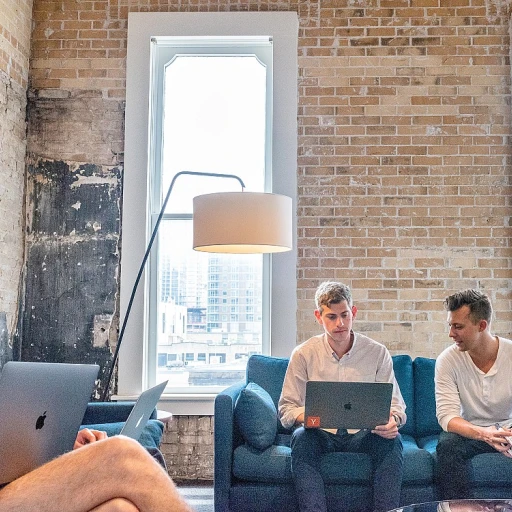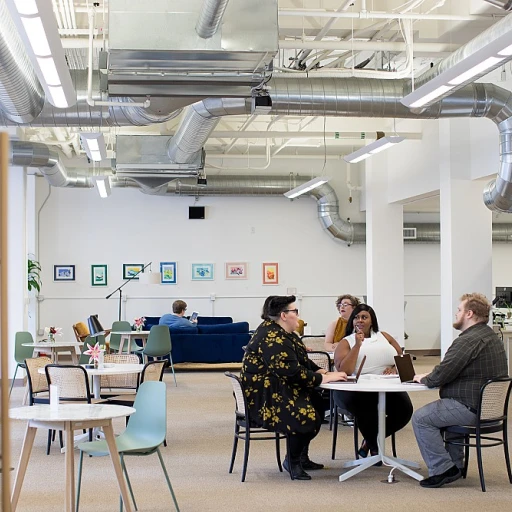
Understanding Collaborative Workspaces
Exploring the Essence of Collaborative Workspaces
Understanding the concept of collaborative workspaces has become indispensable in the modern workplace. These spaces are designed to enhance collaboration, fostering an environment where team members can share ideas and work together effectively. The emphasis on office design plays a key role in accommodating team dynamics, whether it's in an open office setup or in smaller, dedicated meeting rooms.
In recent years, there has been a substantial shift from traditional office space paradigms to more flexible and adaptive layouts. This change aims to maximize the workspace experience by integrating innovative design elements and technological advancements. From conference rooms equipped with video conferencing tools to collaboration spaces where small groups can engage in collaborative working, these areas of evolution are all part of creating a conducive work environment.
The influence of technology is profound, with digital tools altering how teams interface and function. These advancements, alongside a keen understanding of space management, are crucial in shaping modern collaborative workspaces. For more in-depth insights on space management complexities, you can explore this resource on space management in the future of work.
Ultimately, collaborative workspaces are not just about physical spaces. They embody a company culture that fosters interaction, creativity, and productivity, making it vital to stay informed and agile in adapting to their evolving nature.
Technological Innovations Driving Collaboration
Technological Innovations Shaping Collaborative Dynamics
The integration of advanced technology is revolutionizing how we approach collaborative workspaces. As companies strive to enhance productivity and team collaboration, technological innovations become critical.
First, video conferencing and collaborative tools have drastically transformed traditional meeting environments. The accessibility of high-speed internet has facilitated seamless communication across borders, making video conferencing a mainstay in both conference rooms and open spaces. This development not only enhances team interaction but also allows for real-time sharing of ideas and resources.
Furthermore, smart technologies are reshaping the way spaces are utilized. Office design is now geared toward flexible setups that adapt based on the needs of employees. Interactive whiteboards, smart lighting, and sound control systems are becoming staples in creating an efficient workspace. These technologies ensure that collaborative spaces are optimized for varied working styles, whether it's a brainstorming session or a focused work hour.
The use of cloud computing and digital collaboration platforms further underlines the shift in workplace experience. Platforms like Slack, Microsoft Teams, and Trello have become essential in organizing tasks, facilitating team members in small and large groups to stay connected and engaged. This is vital as it supports the company culture, allowing people to share insights and work collaboratively even in flexible or remote settings.
Additionally, the concept of a collaborative office heavily integrates technologies that enable employees to customize their work environment. From media scape technologies that allow content sharing among a small group, up to the innovative apps managing meeting room bookings, these tools streamline processes and enhance the overall experience of collaborative working.
For more insights on space management in future work environments, consider exploring related resources that delve into optimizing office space efficiently.
Designing Spaces for Effective Collaboration
Creating Environments That Foster Team Interaction
The design of a collaborative workspace is crucial to facilitating effective collaboration. Harmoniously integrating office design with technology enables teams to work more efficiently and enhances the overall workplace experience. This involves considering the physical layout, as well as the tools and resources available to team members, to create spaces that support individuals and small groups in their collaborative working efforts.
While open spaces encourage communication and idea sharing, they should be balanced with quiet areas for focused work. The modern office is increasingly designed as a blend of open-plan areas, dedicated meeting rooms, and more intimate spaces that foster both group dynamics and individual productivity. A media scape or collaborative workspace utilizes comfortable, flexible furniture arrangements to facilitate discussions and brainstorming sessions.
In addition to furniture and layout, technology is a cornerstone of modern office spaces. For instance, video conferencing capabilities in both large conference rooms and small team-focused meeting rooms allow remote employees to connect seamlessly with their onsite colleagues, enhancing collaborative efforts. Shared screens and digital whiteboards can aid visualization and planning, while ensuring that team members remain engaged and informed.
The aim is to create a flexible work environment that adapts to the diverse needs of employees. Whether it’s a room designed for informal collaboration, an area set up for a formal presentation, or a dedicated zone for quick team check-ins, flexibility is key. By understanding these elements, organizations can design collaborative workspaces that not only elevate work performance but also enhance employee well-being, productivity, and company culture.
The Impact on Employee Well-being and Productivity
Fostering a Holistic Work Environment
Creating an environment that prioritizes employee well-being and boosts productivity is crucial for any organization. Collaborative workspaces are designed to foster a sense of community and promote creative thinking. They are not merely about the aesthetic appeal or open concept but focus on accommodating different types of work and work styles.
A significant benefit of collaborative workspaces is the promotion of a healthier work-life balance. When employees feel more engaged and connected with their team members, their overall job satisfaction improves. Spaces that encourage collaboration, like an open office design, facilitate spontaneous interactions and can lead to increased innovation.
The Importance of Space and Technology
The right mix of space and technology plays an essential role in enhancing productivity. Collaborative spaces often feature adaptable furniture and media scapes to accommodate different work modes—from focused individual tasks to group brainstorming sessions. For instance, a conference room with state-of-the-art video conferencing tools ensures seamless connections for remote teams, maintaining the flow of collaborative efforts regardless of location.
Meeting rooms in collaborative workspaces are no longer confined to one purpose but are versatile in function. Employees can easily transition from solitary work to team meetings within a well-designed collaborative environment. This fluidity enhances the workplace experience, leading to a more dynamic and effective work environment.
Encouraging Employee Well-being through Design
The way office spaces are designed can greatly impact the mental and physical health of employees. Natural light, ergonomic furniture, and areas designated for rest or socializing contribute to a positive work environment. Allowing people the flexibility to choose their work setting, whether a quiet collaborative workspace for concentrated work or an informal lounge for team collaboration, also enhances productivity and well-being.
There is a growing recognition that a well-rounded office design is not just a luxury, but an essential component of employee productivity. As companies continue to explore these designs, the focus will remain on creating environments that support the comprehensive needs of the workplace.
Challenges and Solutions in Collaborative Environments
Overcoming Obstacles in Shared Work Environments
While the advantages of collaborative work are substantial, organizations frequently encounter challenges when adapting to collaborative workspaces. These challenges can hinder productivity and the overall effectiveness of such environments.
Firstly, one significant issue is the open concept prevalent in many modern office spaces. Open work areas are designed to promote communication and collaboration among team members. However, they can sometimes lead to distractions, reducing productivity. Research indicates that noise and lack of privacy are two common complaints among employees working in open collaborative office environments. To tackle this, office design can incorporate quiet zones or designated areas where individuals can focus without interruption.
Another challenge lies in meeting room availability. As companies shift towards more participative workspace models, the demand for efficient meeting rooms and conference rooms increases. This can often result in double bookings or conflicts over spaces. Implementing smart technology solutions can assist in managing these resources efficiently, ensuring team members have access to the spaces they need when they need them.
Integration of technology in collaborative spaces often poses another barrier. While technology is a driving force in modern office design, not all employees may be tech-savvy. This can lead to frustration when using advanced tools such as video conferencing systems or interactive media scapes for collaborative working. Organizations can address this by providing regular training sessions to increase comfort and competency in using such technologies.
Lastly, balancing collaboration with work-life balance is critical. In efforts to foster teamwork culture, there's a risk of employees feeling pressured to always be "on," connected, and collaborative, which can lead to burnout. To mitigate this, companies should establish clear boundaries and encourage balance, ensuring that employees have designated times for collaboration as well as individual work.
Despite these challenges, with thoughtful design and strategic implementation, businesses can create an adaptable work environment that enhances both employee satisfaction and productivity. Implementing effective solutions enables organizations to maintain a positive workplace experience that supports a thriving company culture.
Future Trends in Collaborative Workspaces
Emerging Directions for Collaborative Spaces
As we look ahead, several trends are poised to shape the future of collaborative workspaces, focusing on optimizing the work environment for productivity, flexibility, and well-being. Organizations are increasingly acknowledging that the traditional office space model may not suit the evolving needs of a modern team. Here’s what the future holds for collaborative spaces:
- Technology-Enhanced Workspaces: With the rapid integration of technology, office spaces are transforming into highly adaptable environments. Video conferencing and media scape installations are now commonplace in meeting rooms, enabling seamless communication for small groups and large teams working across different geographies.
- Flexible and Dynamic Design: Future office design will lean towards multipurpose spaces that can easily transform to accommodate various collaborative activities. Think spaces that can shift between a formal conference room setup and more informal areas for brainstorming sessions, promoting an open and inclusive company culture.
- Focus on Employee Well-being: Employee well-being is paramount for sustained productivity. Collaborative workspaces will continue to evolve with a focus on ergonomic designs and wellness features that contribute to a healthier and more productive workplace experience.
- Sustainability in Space Utilization: As more businesses emphasize sustainability, the design of offices will reflect eco-friendly practices. This may involve using sustainable materials, implementing energy-efficient technologies, and creating spaces that maximize natural light and ventilation.
- Inclusive Collaborative Environments: The future workspace will aim to cater to diverse team needs, emphasizing accessibility and inclusivity. Features such as quiet zones, collaborative hubs, and inclusive facilities will ensure all team members can engage effectively and share in the collaborative working experience.
By staying attuned to these trends, organizations can create collaborative workspaces that not only boost productivity but also cultivate a strong sense of team unity and engagement among employees. Each of these emerging directions is a testament to the transformative power of thoughtful workspace design.












